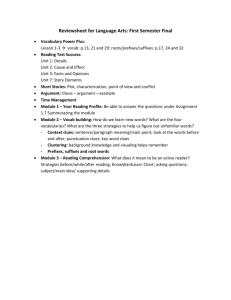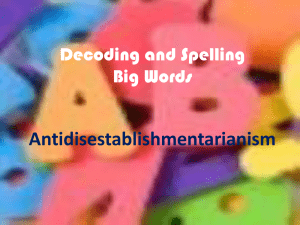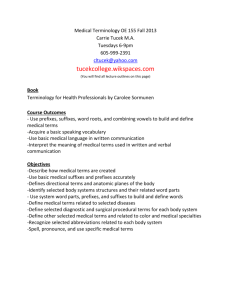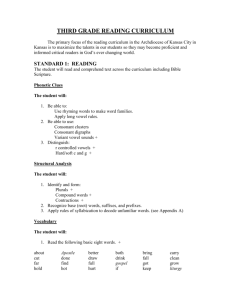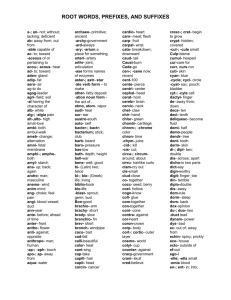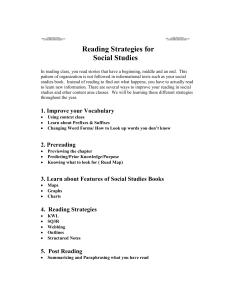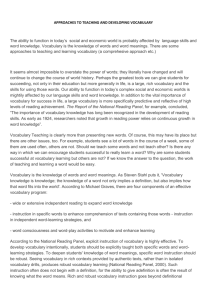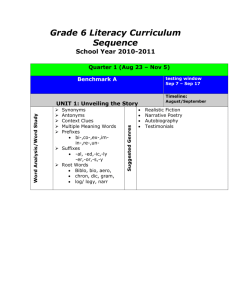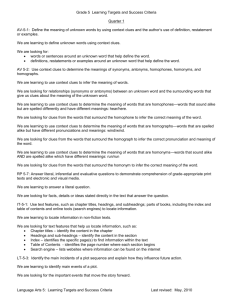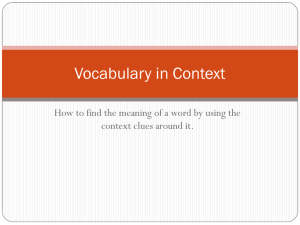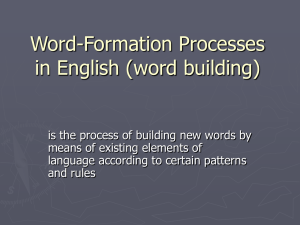Prefixes, Suffixes, and Roots
advertisement
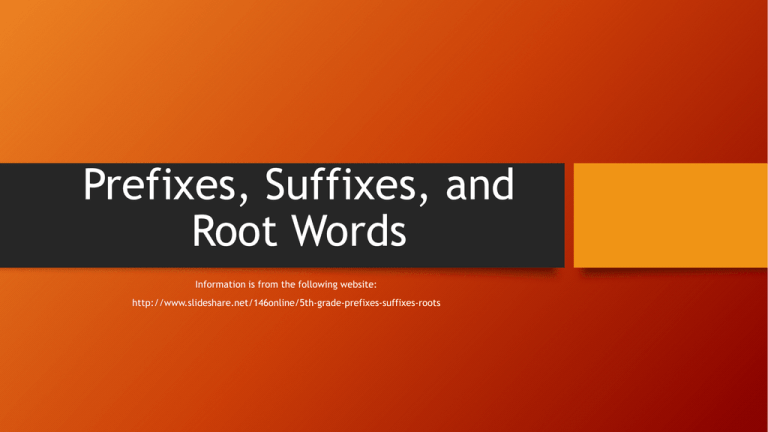
Prefixes, Suffixes, and Root Words Information is from the following website: http://www.slideshare.net/146online/5th-grade-prefixes-suffixes-roots Why learn about prefixes, suffixes and root words? Understanding prefixes, suffixes, and roots can help you to determine the meaning of new and unfamiliar words as you come across them while reading. Prefixes A prefix is a group of letters added before a word or base to change its meaning and form a new word. The most common prefixes (with their meaning in parenthesis) dis- (not, opposite of) Examples: disagree, discomfort in-, im-, il-, ir- (not) Examples: injustice, impossible, illegal, irregular re- (again) Examples: rewrite, return, repeat un- (not) Examples: unfriendly, unsure Suffix A suffix is a group of letters added after a word or base and form a new word. The most common suffixes (with their meaning in parenthesis) -ed (past tense verbs) Examples: jumped, hopped -ing (present participle) Examples: running, eating -or, -er (one who) Examples: actor, teacher, driver -less (without) Examples: fearless, hopeless -logy (study field of) Examples: biology, geology -s, -es (more than one) Examples: books, boxes Suffixes to learn in 7th grade -ic (relating to/characterized by) Examples: energetic, historic, epidemic -ive, -ative, -itive (inclined/tending toward an action) Examples: festive, talkative, active, sensitive Root words A root is the most basic form of a word that is able to convey a particular meaning. The most common root words (with their meaning in parenthesis) aud (sound) Examples: audible, audiotape bio (life) Examples: autobiography, biology meter (measure) Examples: thermometer, odometer port (carry) Examples: transport, portable Root words to learn in 7th grade contra, counter (against) Examples: contradict, contraband, encounter, counteract form (to shape) Examples: conform, reform, transform mater, matr (mother) Examples: maternal, matrimony pater, patr (father) Examples: paternal, patriot sect, sec (to cut) Examples: dissect, section, intersection, bisect Root words to learn in 7th grade (continued) belli (war) Examples: belligerent, bellicose, rebel anthropo (man; human; humanity) Examples: anthropologist, philanthropy mono (one) Examples: monopoly, monologue, monotonous phil (love) Examples: philanthropist, philosophy hydr (water) Examples: hydration, dehydrate, hydraulic Use context clues to help solve the meaning of a word. Information is from the following websites: http://www.woodland.k12.mo.us/faculty/rgarner/reading/context_clues.htm https://www.youtube.com/watch?v=73p_oKEYqTQ Context Clues-What are they? Context clues are bits of information from the text that, when combined with prior knowledge, allow you to decide the meaning of unknown words in the story or article you are reading. As a reader you must act similar to a detective and put together clues from sentences surrounding an unknown word in order to make an intelligent “guess” as to what the definition of a word is. Four types of context clues 1.Examples or Rewording 2. Synonyms 3. Antonyms 4. Drawing Conclusions Examples or Rewording Rewording or examples is when the author says the word in another way, that is typically easier to understand. Example: “Resentment, a feeling of bitterness and anger, is often felt by people who are passed over for promotions.” What does the word resentment mean in the sentence? A feeling of anger and bitterness Synonyms Synonyms are used as context clues when an author uses a similar word for a word which you might not already know the definition. Example: “The young girl was very aloof. She always seems unsociable, unapproachable, and uninterested.” What does the word aloof mean? Unsociable, unapproachable, or uninterested Antonyms Antonyms are used as context clues when an author uses a word (or a phrase) that means the opposite of the word you might not understand. Example: We thought the athletes would be famished after their game, but they were not hungry at all. What does the word famished mean? Hungry Drawing Conclusion Drawing conclusion is when you have to look at the general meaning or logic of the sentence and passage. You must draw conclusions based on the information given. To do this, you should ask yourself questions about the passage. Answering these questions will often lead you to a reasonably accurate guess about the meaning of the word. Example: It took two days for the volunteers to extricate the little girl from the bottom of the well. What does the word extricate mean? Hint…To figure out the meaning, you need to ask yourself what volunteers might do if a small child was stuck in a well. To free or release Don’t forget!!! Understanding and remembering prefixes, suffixes, and root words can help you to determine the meaning of new and unfamiliar words as you come across them while reading. Understanding and remembering the different types of context clues will help you to decide the meaning of unknown words in the story or article you are reading.
